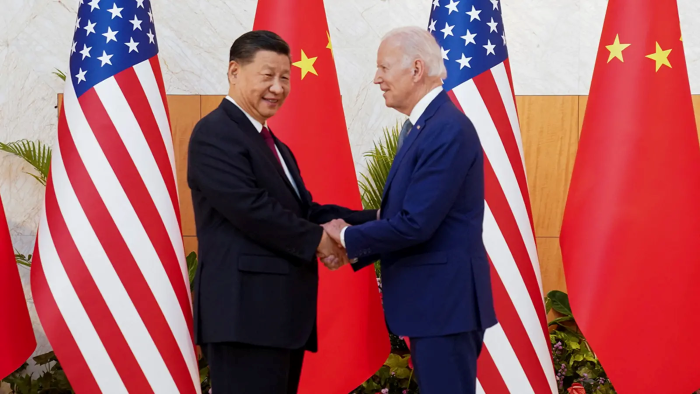
The year 2024 marks the 45th anniversary of diplomatic relations between China and the US. On 01 January, President Xi Jinping and President Joe Biden exchanged letters of congratulations on this historic occasion. For 45 years, Sino-US ties have weathered winds and rains and come a long way.
Bilateral trade surged from less than USD 2.5 billion in 1979 to close to USD 760 billion in 2022; two-way investment increased from almost zero to over USD 260 billion; and 284 pairs of sister provinces, states and cities were set up. The two countries have also carried out useful cooperation on various international and regional hotspots and global issues.
A brief look at the history of the ties between the two nations makes interesting reading, dating back to 1784, only eight years after the US Declaration of Independence. A ship called the Empress of China became the first vessel to sail from the US to China, carrying Samuel Shaw, who had been appointed as an unofficial consul by the US Congress, but he failed to gain diplomatic recognition for the US The visit however, marked the new nation’s entrance into the lucrative China trade in tea, porcelain, and silk. During the 19th Century, British merchants, seeking a commodity to trade for Chinese goods, began to smuggle opium into China, which was emulated by the Americans.
After spending 12 years in the China trade, Philadelphia merchant Nathan Dunn returned from China in 1839, with an enormous collection of art, artefacts, botanical samples and other items and put them on display in a “Chinese Museum” designed to give visitors a glimpse of China. In 1839, the Opium Wars started between China and Britain, ending in a victory for the latter. Resultantly, Qing Government was constrained to sign the Treaty of Nanjing, which ended the existing system of trade through officially licensed merchants, opened four new treaty ports to trade (including Shanghai), granted most favoured nation status to Britain, and provided the basis for the expansion of trade even with other Western nations.
In 1843, US Secretary of State Daniel Webster sent Caleb Cushing to China as Minister Plenipotentiary to negotiate a treaty with the Qing Monarch. After a long wait, the US and China signed a treaty, marking the beginning of official Sino- US diplomatic relations. Starting in 1847, Chinese labourers, known as “coolies,” started being brought to the US to work in mines, on railroads, and in other mostly menial tasks. Over 100,000 Chinese came to the US within the first 20 years. In 1872, the first delegation of Chinese students came to the US In 1875, the US Congress passed the Page Act, which barred entry for Chinese coolie labourers and women brought in for prostitution.
In 1878, China finally established a diplomatic mission in Washington, D.C., with Chen Lanping appointed as the chief of mission, marking the beginning of full Sino-US bilateral ties. Unfortunately, in 1882, anti-Chinese lobbying gained prominence, resulting in the Congress passing the Chinese Exclusion Act, suspending Chinese immigration to the United States for ten years, which marked the beginning of some sixty years of exclusion. The Sino-Japanese Wars wreaked havoc in China which joined the Allies during the First World War, hoping to regain the territory lost to the Japanese but the Treaty of Versailles following the war, did not endorse the Chinese aspirations.
In 1921, the Communist Party of China (CPC) was established but the CPC and the Nationalists (Kuomintang) remained in a state of conflict. In 1928, the US became the first nation to recognize the Nationalist regime as the legitimate Government of China. In 1937 the second Sino-Japanese War took place and Japan occupied Chinese territory, unleashing a new reign of terror on the people. In 1942, China joined the US in a wartime alliance with the hope of defeating Japan and expelling it from Chinese territory. When the war ended—with the surrender of Japan—the Nationalists regained control of China and a civil war started which ended with a defeat for the Kuomintang, who sought refuge on the tiny island of Taiwan, while the People’s Republic of China (PRC) was established in 1949. The US recognized the Kuomintang in Taiwan as the Republic of China (ROC), ignoring PRC, even making ROC a member of the UN Security Council with veto power. This situation worsened with the Korean and Vietnam Wars.
Pakistan facilitated US Secretary of State Henry Kissinger’s clandestine visit to Beijing in 1971 which paved the way for PRC formally joining the UN and President Nixon’s famous visit to China in 1972. Sino- US formal diplomatic ties were resumed on January 1, 1979, and thereafter Deng Xiaoping visited the United States. The rest is history, with numerous challenges, where China struggled, joining APEC and signing the NPT in 1991, finally gaining WTO membership in 1991. Despite the last decade’s trade restrictions against China and the US backing QUAD, AUKUS, Indo-US Military Alliance and provoking visits to Taiwan, China’s US policy has remained consistent and clear, namely mutual respect, peaceful coexistence and win-win cooperation. According to the Chinese Foreign Ministry, Beijing is committed to a stable, sound and sustainable Sino-US relationship and is ready to work with the US to advance mutually beneficial cooperation, shoulder responsibilities as major countries and promote people-to-people exchanges so as to steer the relationship in the right direction to the benefit of both countries and the world at large.
—
The writer has served in Pakistan Air Force, analyst, authored 12 books: Rising Hindutva & Its Impact on the Region, 100 Years of CPC & Tormented Truth–1971 & Beyond… Email: sultanm.hali@gmail.com


